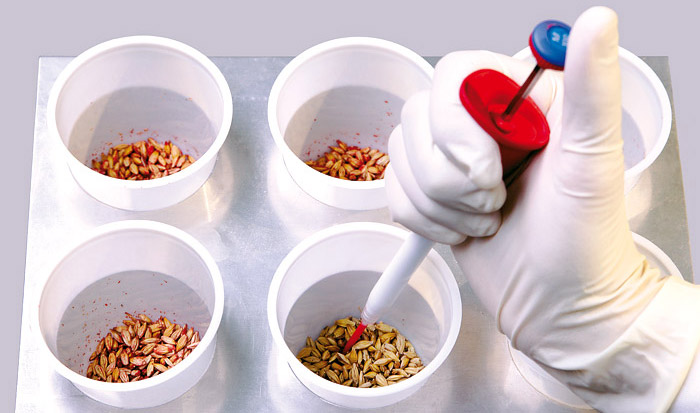Agriculture forms the backbone of any economy. It is dependent on a successful crop production which in turn depends on healthy growth of seeds sown in the fields. Untreated seeds stand the risk of being attacked by various pests and diseases. With advances in technology, seed treatment has emerged as an effective way to protect seed health and promote early seedling growth.
What is Seed Treatment?
Protecting the Seed
Seed Treatment involves applying crop protection products like fungicides, insecticides and other active ingredients directly onto seeds before sowing. This protects the seed and developing seedling from getting infected by soil-borne pests and diseases in the early stages of growth. Common seed-borne diseases that threaten crop establishment include various fungi causing seed rots, seedling blights and damping off. Treating seeds shields them from these threats and allows for healthy germination and emergence of seedlings.
Key Benefits of Seed Treatment
The key benefits of seed treatment are:
– Disease Protection: Treated seeds are insulated from soil-borne fungal diseases such as Rhizoctonia, Fusarium and Pythium which cause seeds to rot before germination or kill seedlings shortly after emergence. This ensures better plant stand establishment.
– Insect Protection: Seeds are fortified against common insect pests like wireworms, seed corn maggots and aphids. Treated seeds are less prone to insect damage during germination and seedling stages.
– Early Vigor: Healthier seedlings emerge from treated seeds. These seedlings exhibit more vigorous growth and are able to establish themselves quickly compared to seedlings from untreated seeds.
– Yield Improvement: Better plant populations and plant protection lead to improved yields. On an average, seed treatment increases crop yields by 2-4%.
– Cost Effectiveness: Seed treatment costs only a fraction of the total input cost but provides maximum returns by ensuring stand establishment and higher yields.
Types of Seed Treatment Formulations
A variety of formulations are used for seed treatment depending on the target pest complex. Some of the common formulations are:
– Wettable Powders (WP): Dustable powder formulations that stick strongly to seed coats when mixed with water. Often contain multiple active ingredients.
– Suspension Concentrates (SC): Liquid formulations containing solids suspended in solution. Can encapsulate seeds for longer residual effectiveness.
– Flowable Suspensions (FS): Thick liquid formulations that flow freely. Uniformly coat seeds like wettable powders but are easier to handle.
– Water Dispersible Granules (WG): Granular formulations that disperse easily and uniformly in water to form a suspension. Adhere tenaciously to seed.
Wide Range of Seed Treatment Applications
Seed treatment has wide scope across different crops:
Cereals – Wheat, rice, maize, sorghum – Treated against major seed and soil-borne fungal diseases and insect pests. Helps attain optimal plant stands.
Pulses – Soybean, chickpea, pigeonpea – Protects from Rhizoctonia blight, Pythium blight, seed rot fungi and insect damage. Enhances crop establishment.
Oilseeds – Groundnut, sunflower, soybean – Fortifies against bacterial and fungal rots, seedling blights and seed insect damage. Helps realize higher yields.
Vegetables – Tomato, onion, cucurbits – Shields from damping-off causing pathogens, seed rot fungi and soil insects. Ensures healthy transplants and seedlings.
Fruits – Citrus, mango, grapes – Safeguards from seed-borne fungal infections. Promotes better nursery plant growth.
Flowers – Rose, gerbera, orchids – Defends against seed and seedling diseases. Improves quality and performance of flowering plants.
Advancing Seed Treatment Technologies
Research is ongoing to develop more effective seed treatment solutions:
– Novel formulations – Encapsulation technologies, longer residual coatings to extend seed protection window.
– Integrated strategies – Tank mixes, pre-mixtures combining fungicides, insecticides to widen pest spectrum.
– Biological seed treatments – Microbes like PGPR, Trichoderma that colonize seed surface and confer protection.
– Seed pelleting/coating – Binding agents to form a durable pellet around seed prolonging effectiveness.
– Seed priming – Partial hydration activates natural defense mechanisms and metabolism for healthy germination.
Seed treatment is a vital crop protection intervention that helps secure stand establishment. With further innovations, it promises to become more convenient and efficient in delivering quality seeds and higher productivity. When integrated with other good agronomic practices, it plays a major role in sustainable agricultural production and global food security.
*Note:
1. Source: Coherent Market Insights, Public sources, Desk research
2. We have leveraged AI tools to mine information and compile it

